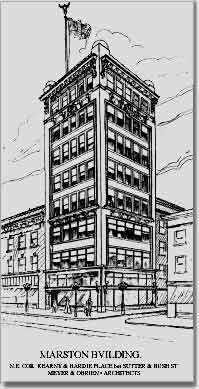Famed architect Charles Peter Weeks wrote this article a few weeks after the Great Earthquake and Fire, and joined the controversy over rebuilding the city. What is so fascinating is the absence of concern about the dreadful effects of the earthquake.
Who is to Blame for San Francisco's Plight
By CHARLES PETER WEEKS, ArchitectBURNING purifies -- burning was once a punishment for crime. Today it is not the same crime nor the same burning, but a burning for crime just the same. The olden crime was against religion. Today's crime is against economics.
Two hundred million dollars have been tossed into the air in the San Francisco fire. Let us find out the criminals.
To an extent ignorance wears the guilty stripes but short-sighted greed, carelessness and weakness are the real criminals.
The owner is primarily to blame for the loss in the San Francisco fire and rightly suffers for his own crime. But the city, too, is to blame for absolute lack of complete inspection of building plans and buildings, weak building laws and affording no protection to the careful owner against his reckless neighbor. The architect is to blame in being too willing to acquiesce in the owner's desire to build cheaply in fear of losing a commission.
The contractor is to blame for not giving golden workmanship for golden recompense.
This school of experience to which we have all paid a large tuition should teach us all in future to stop crimes and avoid their results.
By what right do you endanger my office building by erecting your wooden shack alongside? Is there not room enough for such houses outside of the business district?
Why are not specifications read and buildings inspected by the authorities so that inferior workmanship cannot exist? Why is the owner penny wise and pound foolish?
Why is the architect not a big enough man to refuse to build cheap and to see that he builds strong?
In New York the money lenders employ architects to inspect plans and specifications and buildings to see that their interests are protected. San Francisco would do well to adopt this custom.
When a city is down and out, the thing to do is to bring it to life. If pine and galvanized iron will do it let us use them. But care must be exercised that the same old greed does not mislead us.
It is not necessary to give a warning note to all for many are planning to rebuild a class "A" city. Many men who, before the fire, would have contented with wood are now planning for fireproof structures. Reinforced concrete is the joyous cry of the hour, echoing the death knell of hollow tile.
There is undoubtedly a tendency to blindly fly to reinforced concrete, knowing by experience that all other materials failed. Reinforced concrete was not subjected in our late fire to the same test as other materials.
If a brick wall cannot be honestly built, how much less is a reinforced concrete building liable to be well built?
Reinforced concrete buildings in other parts of the country have not all been successful. The best built buildings are the best, in reinforced concrete as well as other material. Therefore, it will be well for the owner to be careful in the selection of his designer.
This material, in combination with good brick will undoubtedly form a great part of San Francisco's future big buildings.
The elimination of stone and the restriction of projecting cornices will modify the style of future buildings and have a tendency to produce a logically artistic facade in the hands of well trained designers.
A Gothic style is more in harmony with the structural form of a steel building than the classic style and will be followed and adopted more and more in the future.
The Architect and Engineer of California
June 1906